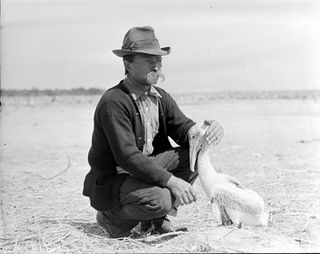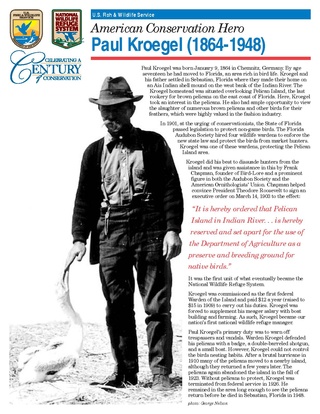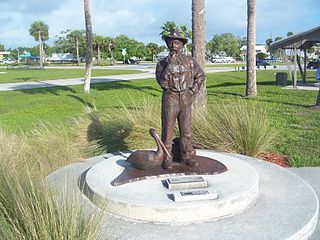Paul Kroegel
The first employee of the National Refuge System was Paul Kroegel, a Sebastian, Florida resident who fought to stop the slaughter of Brown pelicans in the Indian River lagoon. His efforts convinced Theodore Roosevelt to designate Pelican Island as our nation's first wildlife refuge in 1903.
Biography
Paul Kroegel (1864-1948) was born January 9, 1864 in Chemnitz, Germany. By age seventeen Kroegel and his father had settled in Sebastian, Florida where they made their home on an Ais Indian shell mound on the west bank of the Indian River. The Kroegel homestead was situated overlooking Pelican Island, the last rookery for brown pelicans on the east coast of Florida. Here, Kroegel had ample opportunity to view the slaughter of numerous brown pelicans and other birds for their feathers, which were highly valued in the fashion industry.
Kroegel took an interest in the pelicans and vowed to protect the birds and thier rookery. Although initially he had no authority to protect the brown pelicans on the small island opposite his home he did his unofficial best to distance market hunters from the island. He tried to position his sailboat and 5'6" frame between the faster boats of gunners. He wore a big hat and carried a double-barreled 10 gauge shotgun to make his point. Kroegel did his best to dissuade hunters from the island and was given assistance in this by Frank Chapman, founder of Bird-Lore and a prominent figure in both the Audubon Society and the American Ornithologists’ Union.
In 1901 the State of Florida passed legislation to protect non-game birds. The Florida Audubon Society hired four wildlife wardens to enforce the new state law and protect the birds from market hunters. Kroegel was one of the wardens protecting the Pelican Island area.
Kroegel and Chapman helped convince Theodore Roosevelt to sign an executive order on March 14, 1903 to the effect: "It is hereby ordered that Pelican Island in Indian River. . . is hereby, reserved and set apart for the use of the Department of Agriculture as a preserve and breeding ground for native birds." Pelican Island was the first segment of what eventually became the National Wildlife Refuge System.
Kroegel was commissioned as the first federal Warden of the Island and with that appointment, became our nation’s first national wildlife refuge manager. Kroegel was paid $12 a year (raised to $15 in 1909) by the Federal government and $7 a month by the Florida Audobon Society to carry out his duties. Roosevelt had set up the early refuges by executive order but this did not mean Congress would appropriate any money to guard them. Kroegel was forced to supplement his meager salary with boat building and farming.
Paul Kroegel’s primary duty was to warn off trespassers and vandals. Warden Kroegel defended his pelicans with a badge, a double-barreled shotgun, and a small boat. One of Warden Kroegel's first acts was to erect a large sign on the small island stating "U.S. Reservation--Keep Off". Unfortunately the sign scared off the sensitive birds and he later took it down. Kroegel also planted the U.S. flag on a 50 foot flagpole so everyone could see this had become federal property. He loosely defined the boundaries of the bird reservation as the surrounding waters within gun range. Kroegel defended his avians assiduously but he could not control the birds nesting habits.
After a brutal hurricane in 1910 many of the pelicans moved to a nearby island, although they returned a few years later. The pelicans again abandoned the island in the fall of 1923. Without pelicans to protect, Kroegel was terminated from federal service in 1926. He remained in the area long enough to see the pelicans return before he died in Sebastian, Florida in 1948.
Through his caring for coastal habitats and birds, Paul Kroegel convinced President Theodore Roosevelt to designate Pelican Island as a bird sanctuary and pioneered our nation’s first national wildlife refuge.[1]
A memorial statue of Paul Kroegel stands at Riverview Park on the Indian River in Sebastian, Florida. Unveiled in 2003, the statue was sculpted by Rosalee Hume, a lifelong resident of Sebastian who met Kroegel as a child. The figure of Kroegel looks out at Pelican Island, smoking his pipe, with a couple of pelicans safe at his feet. And on the plaque a few simple words pay tribute to this dedicated guardian of Pelican Island: “One person can make a difference.”



